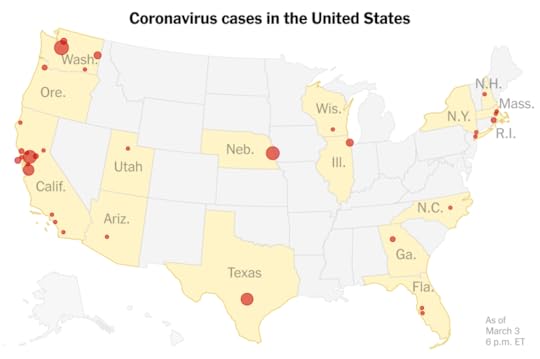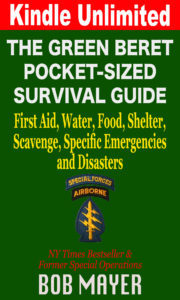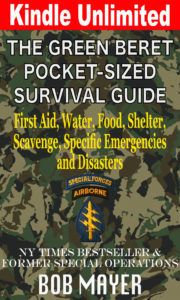As of 4 March 2020. What is Coronavirus ? How does it spread? What should you do to prevent exposure? What about a vaccine?
There’s a Good Chance We Will Be Exposed to the Coronavirus.
Caveat: I am not a doctor and just referring to the information
I have researched.
Why is it likely? Because the unique combination of how long a
person can be infected before it manifests itself and the fact we have no
vaccine for it and won’t have one soon. Also, even with a vaccine, it won’t go
away. It will become something else we need to get a shot for every year. Once
the shot is invented.
Don’t panic, though. You might be asymptomatic (show no symptoms). You may develop mild symptoms and be fine. You might get sick but the odds are you will get through it. The mortality rate is very low. As far as we know right now.
There are two factors to consider: the odds of getting it, and
then the odds that it will be fatal. Again, don’t panic. Read and become
educated on it. I’ll explain as best I can using the latest information as of 2
March 2020.
Background:
Right now, the World Health Organization estimates that Coronavirus has a 3.4% mortality rate. This is higher than the estimate just four days ago. But because it is slow to manifest itself, people who have it show no symptoms and can spread it. This is the danger of Coronavirus: it is deadly, but not overly deadly. A perfect storm of virus. People are testing positive for it without showing any symptoms. Which means it’s spreading right now and we can’t tell how fast and how far.
How does it spread?
The Coronavirus is not airborne like measles or smallpox. It is spread through droplets. This means it is spread by contact with those droplets. It only infects the lungs.

Thus, someone sneezing can spread it several feet around them when sneezing. Use six feet as your blast radius. If you’re sitting on a plane and someone sneezes and doesn’t cover it up, that is the distance they are spreading it, give or take. Not just on you, but on all surfaces around them.
While your mask might protect you from inhaling a droplet, it
can still get on you (and the mask so you can put the virus on your hands if
you touch it or when you take it off) and then in you via contact by your hand
with your nose or mouth.
How long does it last on a surface? This is the most dangerous part you have to factor in to
everything you do.
While much isn’t known right now, here are the best estimates:
Depending on the material and the conditions, human coronaviruses can remain
infectious from 2 hours to 9 days on a surface. At temperatures of around 4°C
or 39°F, certain versions of the coronavirus could remain viable for up to 28
days. At temperatures of 30–40°C (86–104°F), coronaviruses tended to persist
for a shorter time. High humidity also helps it hang around. This is not good.
At room temperature, a coronavirus responsible for the common
cold (HCoV-229E) persisted significantly longer in 50% humidity than 30%
humidity. For working purposes: Human coronaviruses can remain infectious on
inanimate surfaces at room temperature for up to 9 days. At a temperature
of 30°C [86°F] or more, the duration of persistence is shorter. Veterinary
coronaviruses have been shown to persist even longer for 28 days.
The bottom line is that there are variables in how long the
Coronavirus will be viable on various surfaces in varying environments.
Anywhere from several hours, to weeks. We should know more as more research is
done.
But consider the problem this presents. Anything you touch might
have the virus on it. One thing I’ve thought of is Amazon Prime. Think of the
number of people who touch the product and the box before it gets to your doorstep?
The newspaper I get out of the mailbox each morning? This is why the spread
will be so large.
To disinfect for Coronavirus:
Hydrogen peroxide (.5%) or bleach (.1%) appears to work. Chlorhexidine
digluconate, often used as antiseptic, is not effective. Use hand sanitizer
with better than 60% alcohol based. Keep a bottle by every entrance to your
house. Keep it in your car. Use after contacting any possibly contaminated
surfaces.
Containment:
The first goal to prevent a pandemic is containment. While there
is a chance Coronavirus will be contained, it grows less likely each day as
more cases pop up around the world. Particularly when we see it in people who
have not traveled to a contaminated area or, as far as can be determined, have
not had contact with someone who has. The virus, as of 27 February 2020, is in
forty countries. Just a few days ago that number was twenty-four.
Coronavirus has developed in people who were asymptomatic. Thus,
people who appear and test normal, are spreading it. Some epidemiologists
believe that within a year, forty to seventy percent of the people around the
world will be exposed to Coronavirus. Many will be asymptomatic and fine. Some
will have mild symptoms and turn out all right. Those with chronic health
problems and the old are the most at risk of serious complications from it. It
is a virus that causes a respiratory illness.
What are the Symptoms?
Coronavirus causes pneumonia. If infected, you’ll suffer cough, fever
and difficulty breathing. If its severe, there can be organ failure. Because it’s
a viral pneumonia, antibiotics are not useful. Ultimately recovery depends on
the strength of a person’s immune system.
The majority of those who have died had weakened immune systems
or were in poor health to begin with. Heavy smokers are at risk.
How do you protect yourself?
Wash your hands constantly.
You can get it from touching a surface with droplets on it. It persists on
surfaces longer in colder, more humid environments. Using soap and water or an alcohol-based
hand kills the virus that may be on your hands. Dry your hands on a paper towel
you don’t reuse rather than a cloth towel or use an air dry.
When you wash, do it for 10 to 20
seconds. I’ve seen people ridiculing videos and instructions on-line about ‘how
to wash your hands’, since they think that’s a simple skill they learned as a
child. Take your cell phone. Go to the timer. Set it for 20 seconds. Run it.
Never knew 20 seconds was that long, eh? A nurse told me he was taught to
silently sing “Happy Birthday” to himself three times and that was long enough.
Wash your hands constantly. When caring
for the sick. Before, during and after preparing a meal. Before eating. After
toilet use. When hands are dirty. After handling animals or animal waste.
Hands: Don’t shake hands. Use your
knuckles to turn on light switches, use elevator buttons, etc. Use a paper
towel or have gloves on when getting gas. Wear disposable latex gloves when going
out, remembering to not touch your face. Dispose of when entering your home.
Masks? Their effectiveness is debatable
and I see arguments on both sides. The CDC doesn’t recommend that healthy
people wear one. Most people don’t know how to use one properly; they might not
fit well; most dangerously, they can give a false sense of security. Use a mask
if you are caring for someone who is sick. A positive of a mask is to remind
you not to touch your face. An infected person should definitely be masked. If
masked it must cover both mouth and nose.
Gloves: Use disposable latex gloves when
coming in contact with surfaces that could be contaminated. Remember, they will
be contaminated then, but if you don’t touch your face and discard them then
wash your hands, it’s a plus.
Avoid touching your nose and mouth.
If the virus is on
your hands, and you touch either of those, that is how it enters your body. If
you touch food or drink with contaminated hands and then consume it, it can
enter that way.
Practice respiratory hygiene. This sounds fancy but it means
covering your mouth with your bent elbow (not your hand) or a tissue when you
sneeze. Dispose of the tissue.
Avoid close contact with others. This is called keeping social
distancing. Keep at least 3 feet, especially if someone is coughing or
sneezing. Don’t shake hands or hug others.
If you have fever, cough and
difficulty breathing, seek medical care early. Call your health provider and find out where you
should go.
Zinc lozenges:
These have some effectiveness if you use them as scheduled. Lie on your
back while you let it dissolve so it gets to the back of your throat and
nasopharynx.
Stay informed and follow advice. This is an ongoing and fluid
situation, so keep up to date with the latest. One report I saw indicated that
it is possible to get COVID-19 again, after it clears up. I don’t know if that’s
true or not, so stay up to speed.
Practice food safety. Use different chopping boards and
knives for raw meat and cooked foods. Wash your hands when switching between
handling the two.
Protect others from getting sick. If you have fever, cough or
difficulty breathing, isolate yourself and seek medical attention. Don’t go to
work or school and spread it.
Traveling? Avoid it as much as you can.
Avoid nonessential travel. Avoid cruises.
Preparation:

While you should be prepared at a basic level as indicated in my Green Beret Preparation and Survival Guide, there are things you can do now. Consider how you’d prepare if there was a snowstorm in your area. Stock your cupboards with additional food. Canned coup, beans, pasta, rice are good examples. Consider having enough on hand to last several weeks. This is covered in detail under Food in the preparation portion of that book.
Make sure you have aspirin or
ibuprofen on hand.
If you take prescription medicine
have as much on hand as you can.
Consider if you have to home
school. Japan has already closed schools to reopen later in the year.
Consider if you can work from home.
The Vaccine:
Scientists are already at work on vaccines because the Chinese,
once they identified it, sent the data to other scientists around the world.
Making vaccines is difficult. Researchers have to copy the
virus’s RNA, which is happening right now. Then the hard part: finding a viral
sequence that will cause a protective reaction from the body, but not an acute
one that will cause problems of its own. That fine tipping point is difficult
to find. It requires considerable testing or else the solution might be as bad
as the problem.
The best estimates are 12 to 18 months to a vaccine. Even then,
manufacture and distribution will take time. Thus, the next year will be
critical. There are other complications. What if manufacture requires an intact
supply chain and the pandemic has broken that chain? What if one country comes
up with a vaccine but closes its borders until all its citizens are vaccinated?
A large problem is that governments and particularly private
industry, have been unwilling to invest large amounts of money and time into
developing the capability to invent vaccines when there is no urgent threat.
But once there is an urgent threat, it takes time to spin up the mechanism to
do so. The United States recently went backwards in this regard with cuts to
various agencies that research and deal with the possibility of pandemics. It
is not something that can spin up at full speed since they’ve been shuttered.
Also, research needs to be ongoing.
What is a Pandemic?
A pandemic is an epidemic of infectious disease that spreads
across a large region; usually multiple continents. Some of this information
replicates the material for COVID-19, but there is the probability of different
pandemics in the future.
Experts believe the odds of a pandemic within the next fifty
years are very high. Estimates are that: 1 billion people would get sick. 165
million will die There will be a global recession and depression. If you do the
percentage, that’s a 1.65% mortality rate. Currently, it’s estimated that
coronavirus has a mortality rate of under 2%
Why are the odds of a pandemic high?
1. Global population has increased dramatically.
2. People are moving to crowded, central locations: cities.
3. World-wide travel is much faster and more common.
If it’s a true pandemic, it’s not likely that a hospital is a place to go as it will quickly become overwhelmed with the sick and dying. The bottom line is to stay aware and isolate yourself and your team as quickly as possible.

The problem is that the spread of Coronavirus won’t be
instantaneous and burn out just as quickly. If your area is seeing cases it
would be prudent to isolate for a month, but it will probably take longer for
the virus to pass. That is why the chances of contracting it are high. This
isn’t being alarmist, but realistic.
I hope I am wrong about all of this. Nothing I’ve written about
is locked down. There are many variables. but I’ve found it best to be knowledgeable
and realistic about possibilities.



